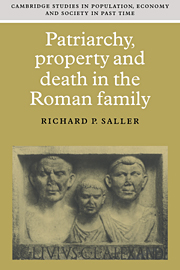Book contents
- Frontmatter
- Contents
- List of tables
- Preface
- Abbreviations
- 1 Introduction: approaches to the history of the Roman family
- Part I Roman life course and kinship: biology and culture
- Part II Roman family and culture: definitions and norms
- Part III The devolution of property in the Roman family
- Bibliography
- Index
- Cambridge Studies in Population, Economy and Society in Past Time
Part II - Roman family and culture: definitions and norms
Published online by Cambridge University Press: 23 November 2009
- Frontmatter
- Contents
- List of tables
- Preface
- Abbreviations
- 1 Introduction: approaches to the history of the Roman family
- Part I Roman life course and kinship: biology and culture
- Part II Roman family and culture: definitions and norms
- Part III The devolution of property in the Roman family
- Bibliography
- Index
- Cambridge Studies in Population, Economy and Society in Past Time
Summary
Basic demographic events influenced the shape of Roman families through the life course, but did not define the boundaries of the family and relations within it. Within a regime of high mortality and limited private property, significant cultural differences may be found from one society to another: one example would be Roman exogamous marriage in contrast to the endogamy characteristic of some eastern Mediterranean cultures. Despite J. Goody's effort to depict the pre-Christian, Eurasian plough cultures, including Rome, as broadly similar in the practice of close kin marriage, and to ground that practice in common economic exigencies, the empirical evidence supports Plutarch's perception of a basic cultural difference between the exogamous Romans and the endogamous Greeks. The distinction dates back as far as the historical texts and is probably beyond the reach of historical explanation.
Against any position tinged with economic or demographic determinism, other historians have adopted radically cultural interpretations, claiming the irrelevance of biological reproduction to the construction of the family. It has been suggested that the Roman family was purely a ritual construct to which newborns were admitted by being ceremoniously “raised up” from the ground by the father. The implication is that there is nothing “natural” about the family, and little constraint of any kind in its construction. The Roman texts, however, do not support this interpretation. Family membership was not defined solely by ritual.
- Type
- Chapter
- Information
- Patriarchy, Property and Death in the Roman Family , pp. 71 - 73Publisher: Cambridge University PressPrint publication year: 1994



